A Study of the Threes Phenomena
(Does it lead to a Scientification of Philosophy?)
| God The Numerologist 1 | God The Numerologist 2 | God The Numerologist 3 |
Progressive Thinkers as of 1/4/2023

3 Essential Keyboard Shortcuts

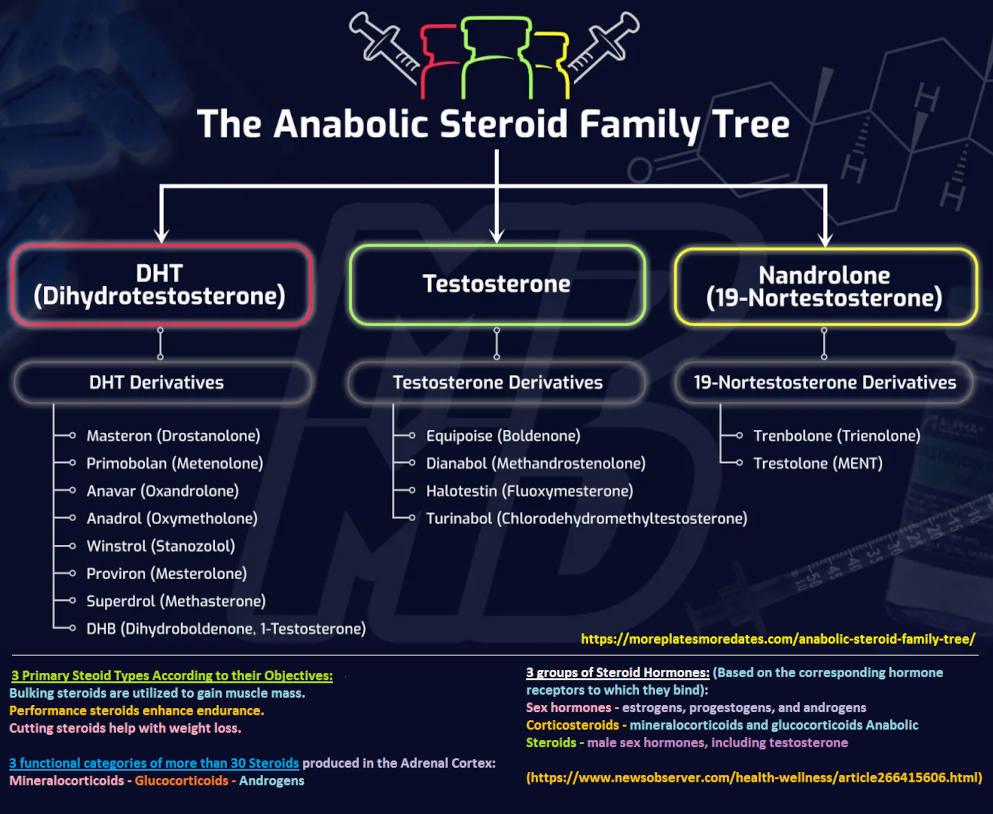
*"8" was previously used for the mono-nucleotide reference in the above triplet code sequence of evolution instead of the conventional "4" to suggest evolution in the biological sense may not have begun until some rudimentary singularity, pairing or triplicity had taken place. The conventional "4 -16 - 64" idea is based on the present day usage of 20 amino acids (as a model of mathematical logic) which may not have existed in the deep past. Only a triplet code satisfies the present day usage of the 20. Singlet and doublet codes are too small, but may not have been so for life's fledgling stages in terms of biological functionality.
Due to design and operation of the Wankel engine, I have referred to it as having 3 strokes, though other (I will assume out of mimicry), are inclined to repeat the disposed notion of it having four strokes like a "normal/regular" engine.
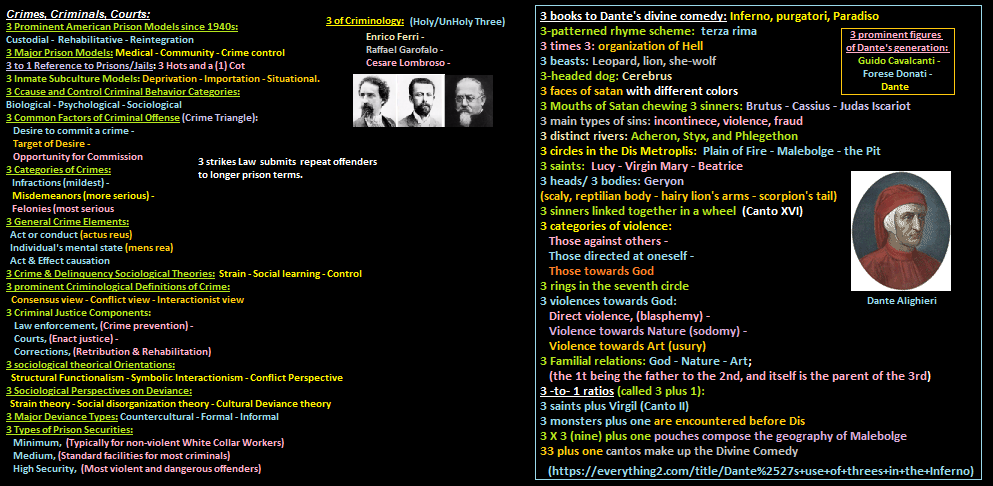
Here's a small collection of T-shirts exhibiting a 3-patterned slogan. And yes, I know there are T-shirts with shorter and longer slogans, which... if this is the model of Categorization we use, we have a Less than three- More than three- Exactly three.

I can't tell you how many times I have gone into stores to purchase this or that tool, all the while observing the different types of sets, one of which is the triple-tool set. You can purchase single-item tools, sometimes two tools such as hammers, pliers, etc., and three-item tool sets. While there are 4 and more quantity sets, I will place all of them into a single category which provides us with a similar cognitive usage found in other subjects. For example, when we look at religion we see the idea of "one" expressed in the concept of a single god or Monotheism. In the past we can pay witness to divine couples or pairs (complimentary or antagonistic to one another). There are of course numerous examples of three in the form of trinities, triunes and triads. After which we encounter the notion of multiple gods variously described as polytheism, pantheon, multiplicity, etc... And yes, there is overlapping, regression as well as mixing and matching, but the underlying counting theme remains and appears to be cyclical. It's a wonder to me why people buy into the idea of a single god when there could be multiple entities just as easily. Then again, if we adhere to science such as particle physics, the idea of three families of fundamental particles would appear to be an example of an idea to support a similar philosophical approach to combat the Egotistically produced Monotheism.

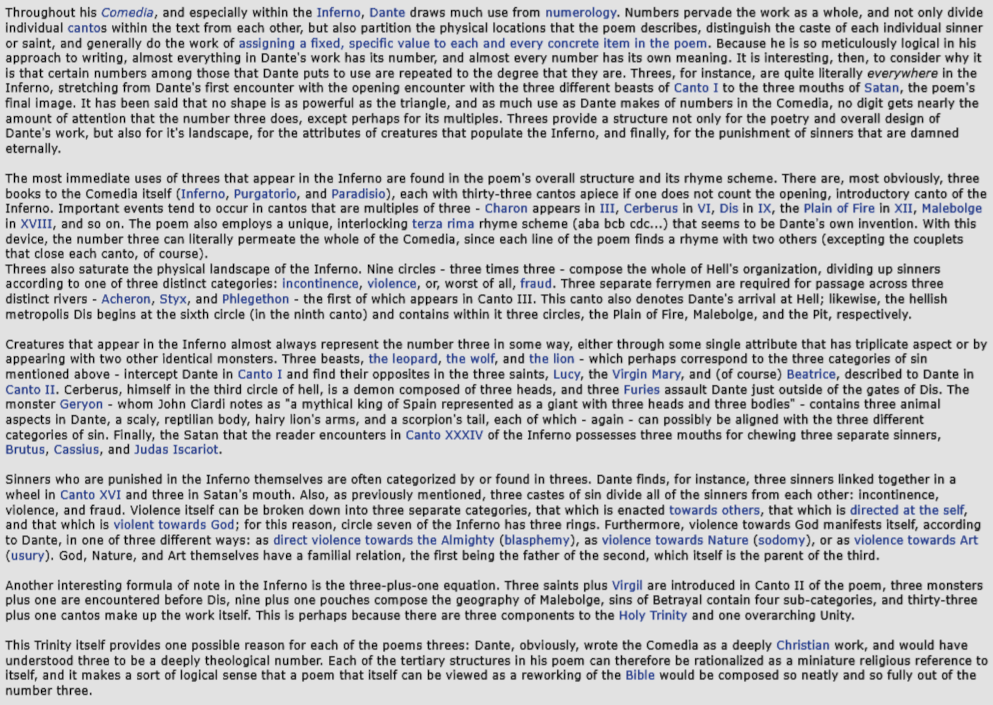
Dante's use of threes in the Inferno
In the foregoing list of threes from Dante's Inferno (a list submitted by Richard Williams), the authors of the list also make reference to a "3 plus 1" pattern which is another way of saying a 3 -to- 1 ratio. Here are the examples they provide:
...Another interesting formula of note in the Inferno is the three-plus-one equation. Three saints plus Virgil are introduced in Canto II of the poem, three monsters plus one are encountered before Dis, nine plus one pouches compose the geography of Malebolge, sins of Betrayal contain four sub-categories, and thirty-three plus one cantos make up the work itself. This is perhaps because there are three components to the Holy Trinity and one overarching Unity.
This Trinity itself provides one possible reason for each of the poems threes: Dante, obviously, wrote the Comedia as a deeply Christian work, and would have understood three to be a deeply theological number. Each of the tertiary structures in his poem can therefore be rationalized as a miniature religious reference to itself, and it makes a sort of logical sense that a poem that itself can be viewed as a reworking of the Bible would be composed so neatly and so fully out of the number three.
One of the problems with claiming that a list of threes in a religious context "naturally and logically" refers to a given religious orientation is that no one addresses the issue of why the value of "three" was adopted by many Christians, and in particular, the drafters of the Bible. Were they conscious of their use of a "three" theme as are many present day writers and speakers in their respective genres, or unconscious of such a usage? Then again, why did the value of "3" come to usurp the value of "7" or the value of "2" with its multiple identities such as divine pairs, antagonistic pairs, dichotomies, dualities, hermaphroditic, etc? No less, why do so many people buy into the idea there is only 1 god? How in the world do you know? Is it because the three born-in-the-desert religions— Judaism, Islam, or Christianity claim this is the case? Why did the idea of a 1 god come to usurp the past ideas of a divine pair, a trinity, or pantheon, and yet such ideas still exist in small enclaves? And why does the human mind only cycle through a limited array of ideological concerns relative to the quantity of a supreme entity? In other words, why so few gods? Why the conservation and concentration towards a single god-entity (singularity) if the human mind is not being subjected to environmental pressures which force it to adopt this strategy as a mechanism of survival in an incrementally deteriorating environment with increasing instances of severe rationing to take place, even if the majority of humanity is not cognizant of such? Those on the fringes of a large raft might be those to pay witness to deteriorations which eat away at the edges, like a desert encroaching on civilization at its borders, and those living at such borders are the first to pay to the sandstorm but may not think much of it if they too are focused primarily on the lush, verdant landscape of a manicured interior.
The cycle appears to involve 3 overall orientations which can overlap, leap-frog, be intermittent, be "punctuated" involving the various human concerns such as anthropological, biological, psychological, sociological (ie. political, economic, religious... etc.):
- Ideas of singularity such as a single god or a singularly chosen people, or singularly chosen place, etc.
- The idea of "Nothingness" or "non-duality" can be viewed as single ideas, even if they involve multiplicity.
- Ideas of duality variously described as dichotomies, pairs, antagonisms, twoness, etc.
- Ideas of triplicity (or expressed as a multiplicity) such as triads, trinities, triunes, triples, ternary, etc.,
- Ideas of multiplicity (which may or may not include three), such as a quadrivium, pantheon, plurality, etc.
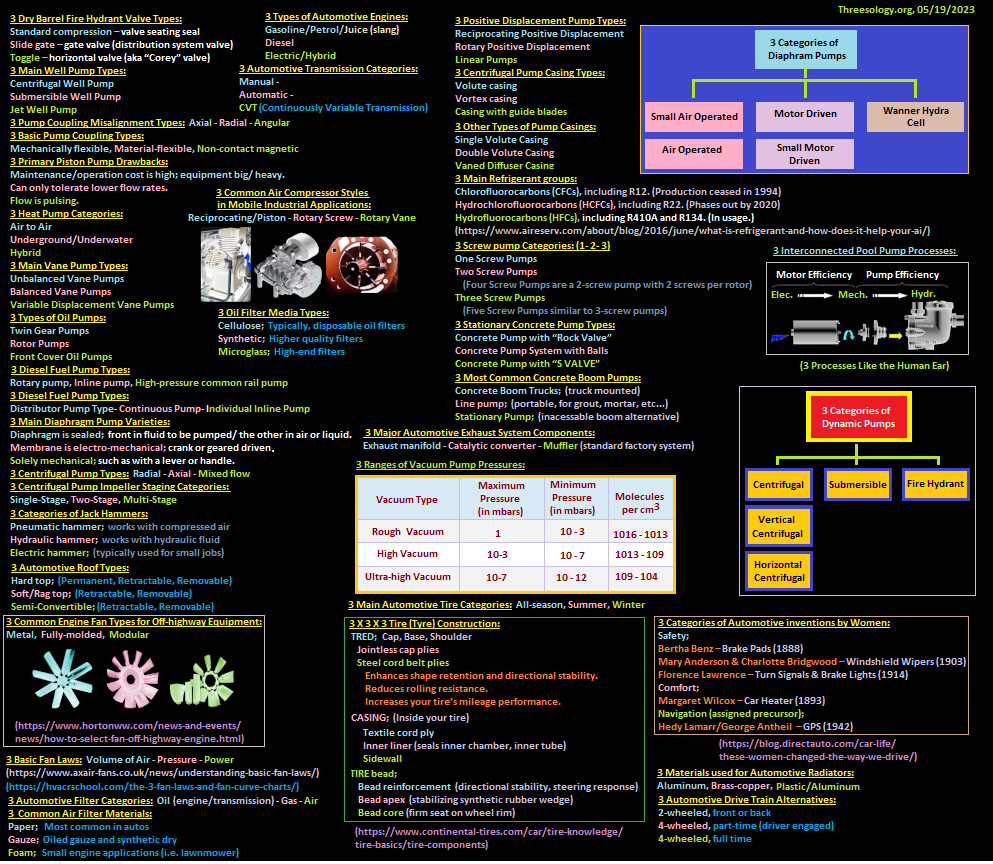
Why only a handful of number patterns and why is the "3" so very prominent if it is not due to an environmental influence signaling an incremental course of degradation? The "1", alternatively described as a singularity, signals that the human mind is adopting the necessary rationale as a survival mechanism... as the environment's resources continue to deplete. In other words, the ideas being espoused by different religions express a rationalized survival approach to the 3 disintegrations of the Sun, Earth and Moon. (The Sun is burning out, the Earth's rotation is slowing, the Moon is receding.) Yes, I fully realize you can find other number patterns, but if you look closely at those observed number patterns you might come to realize they are a recurrence of small numbers, and that if and when you decide to make a list, you will find some number patterns have a greater frequency of occurrence in different contexts, but may be wholly absent in other subject areas. This is an important point to make. It is not that we can't find larger number patterns, but we are not using them on a consistent basis. In all our subjects there is a recurrence of only a few patterns, including those involving Natural phenomena. Nature, at least from a human perspective, focuses in on only a few patterns as indicated by the ideas being generated in biology, physics, anatomy, etc...
Here's a larger list of the "3 -to- 1 ratios" that in the realm of Mathematics might be referred to as "Quaternion's". While a 3 -to- 1 ratio has been acknowledged as occurring in some instances (such as Mendelian genetics), a larger appreciation in multiple other areas of cognitive activity needs to be appreciated. The pattern appears to me to be a representation of the effects of the Sun's three moments (phases: dawn- noon- dusk) on a path towards a fusion as the Earth continues to slow and the Sun enlarges. In other words the pattern is a symbol of a biologically influential environmental event taking place. Similar to the idea in Christianity where it is noted that the Trinity is sometimes referred to as a 3 persons -in- 1 godhead. In other words, this expression illustrates the idea of an eventual fusion to take place with multiple other 3 -to- 1 ratio ideas. While such a cognitive behavior is easily seen in our time period, this may not be the case for future circumstances where 3 -to- 1 ideas are generated as composites. However, one need not be obsessed with using the word "to" since alternatives can be seen. For example, we might say 3 -in- 1 or 3 -with- 1 or 3 -from- 1 or 3 next to 1, or 3 times 1 or s minus 1 or 3 plus 1, or 3 -instead of- 1 or some flip-flopped variation such as the E Pluribus Unum expression denoting an "Out of Many, one"... where the word "many" is an old counting reference to the value of "3" as seen in the expression "One- two- Many", giving us three number words for humanity's early efforts at counting.
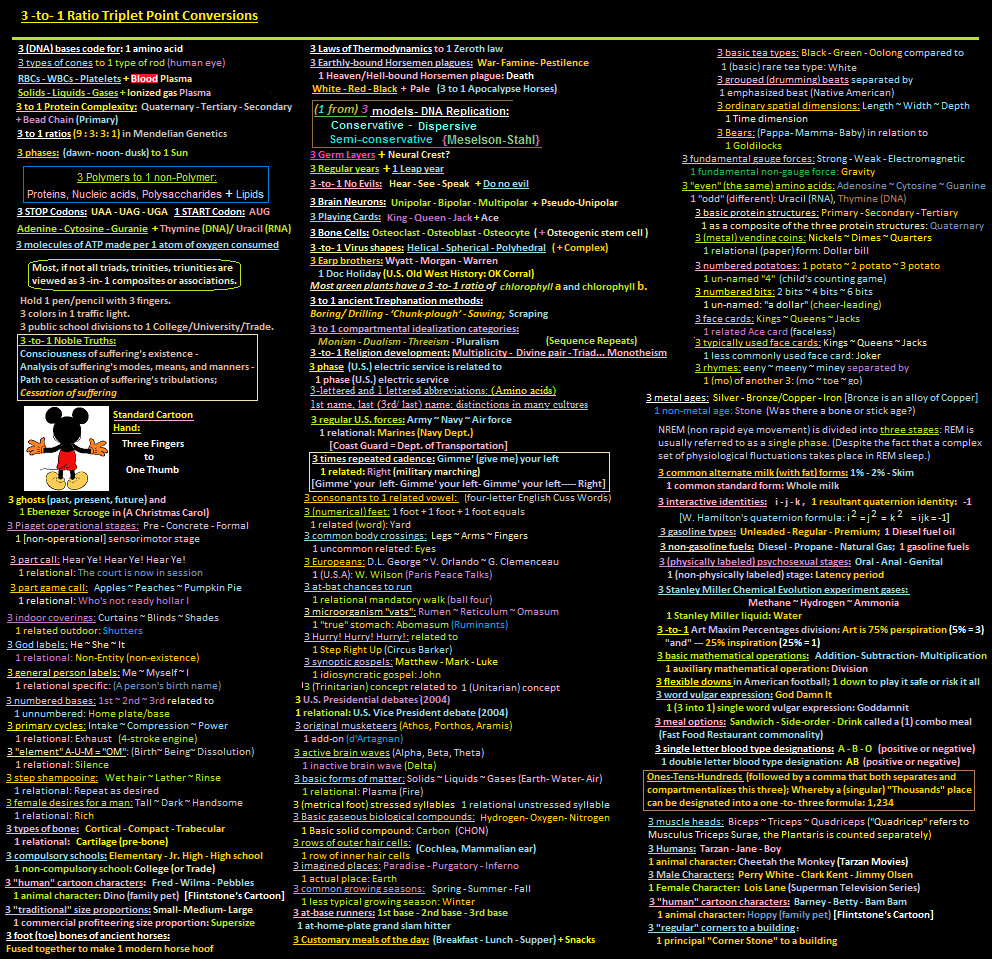
In this section, let me begin by providing you with a few examples of the "threes" phenomena being associated with Natural events. And the information on the chart to the right is culled from Dr. McNulty's "Threes in Human Anatomy". For those wanting the chart, I provide this link to the Anatomy chart.pdf

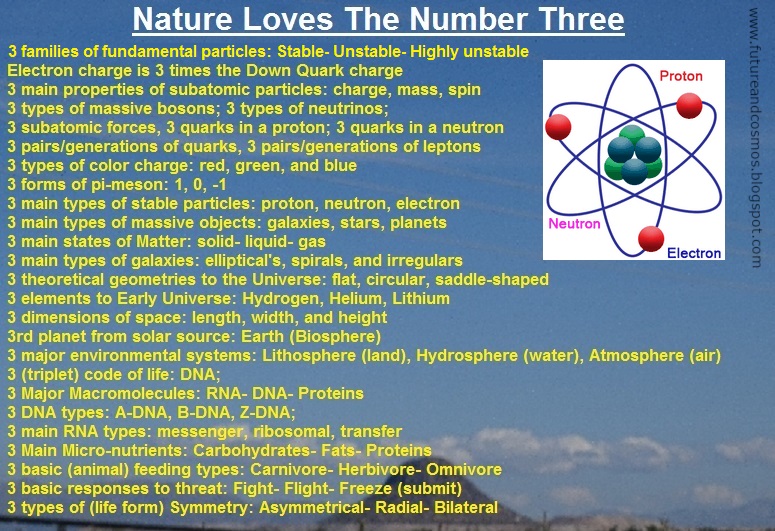
Nature Seems To Love The Number Three by Mark Mahin
Here is a PDF of a list put together by: Scott Anfield. His accompanying commentary can be read at Mike Eck's site: On the Nature of the Universe.
Let me add a few threes-related examples from different perspectives of language. While some readers may have seen a few of them before, they did not make an active mental note of them into a singular compilation. If they had done so, and had done so for other subjects, then the recurring usage of a "three-patterned" cognitive theme might stick out in their consciousness. Here is the most recent compilation which includes a reference to recurring patterns-of-three in hear, since hearing plays such an important role in verbal language:
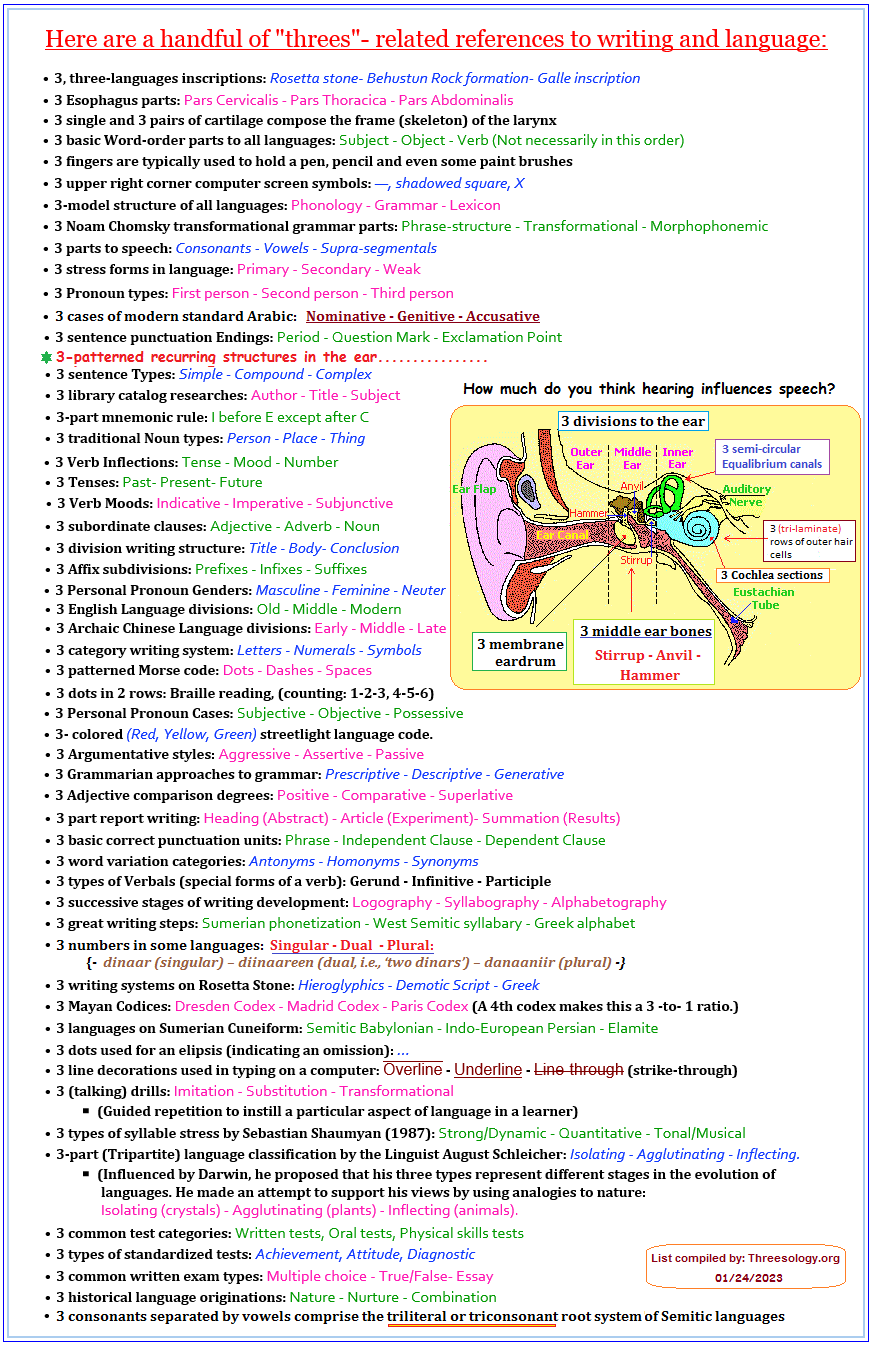
The fact that we are using but a very few number patterns is significant. It also is significant to note that, despite the fact that it is Universally recognized by all Linguists that the ability to hear is of monumental importance for the usage of words, not a single Linguist in the history of the Subject has ever looked at the repeating "3" pattern associated with hearing and made any connection whatsoever to the frequency of 3s usage in speech. This is astonishing that so many intelligent people have collectively overlooked this phenomena in their research. And because I am not in their Academic club, my reference to the presence of a recurring "3" pattern is dismissed as being irrelevant... because someone in their group didn't think of it.
- 3 broad areas of speech production: (Conceptualization, Formulation, Articulation) The Standard Model of Speech Production
- 3 main parts of speeches: (Introduction, Body, Conclusion) Structuring the Speech
- 3 models of Language production: (Serial, Connectionist, Lexical access) Language Production
- 3 basic word elements: (Prefix, Word root [with a combining vowel], Suffix) Word Elements, Prefixes and Suffixes
- 3 parts to a word: (What it means, What it looks like, How it sounds) Three Parts to a Word – an Explanation from Brain Research
- 3 major components of Language: (Form, Content, Use) Components
of Language
- Form involves 3 sub-components: Syntax, Morphology, Phonology.
Vowels and consonants can be considered to be the segments of which speech is composed. Together they form syllables, which in turn make up utterances. Superimposed on the syllables there are other features that are known as suprasegmentals. These include variations in stress (accent) and pitch (tone and intonation). Variations in length are also usually considered to be suprasegmental features, although they can affect single segments as well as whole syllables. All of the suprasegmental features are characterized by the fact that they must be described in relation to other items in the same utterance. It is the relative values of the pitch, length, or degree of stress of an item that are significant. (Suprasegmentals)
You might be a reader who wants to rush in and claim you can find this and that article which presents a different quantity of items, and yet you do not also stop to look at the overall Conservation of Number EVERYBODY is using. In other words, we don't routinely come across researchers using (for example) 17 or 54 or 183 parts to describe fundamentals of language in speech or writing. Every single research focus references only a small quantity of items justified by some notion of inherent conservancy, even if this word, this idea... is not part of the usual linguistic vocabulary you encounter.
Here is an example of a geometric Linear- Circular- Triangular pattern-of-three expression occurring in the development of writing:
In the early period (writing) tablets there is a clear difference between the sharp tool used to draw the curviform lines of the pictographs and whatever was used to make the round holes for numbers that sought to imitate the original look of pressing counting stones into clay. By the Uruk III period we can see that they had developed different sized styluses with round cross sections for making number impressions. There was a gradual transition from the "umbin" as a pointed scratching instrument for writing pictographs to the "gi-dub-ba" reed stylus with a triangular head for making lines and wedges, which happened when writing transitioned from pictographic proto-cuneiform to abstract cuneiform by the time of the archaic Ur and Fara period tablets in the early third millennium. Several centuries after the invention of proto-cuneiform, the Sumerian scribe adopted what became the standard stylus with one end cut to make wedge marks and the other end rounded for making number signs. The appearance of the pictographs transitioned from being drawn with roundish natural-looking lines to being drawn with straight lines and then to the abstract conventions of the wedge-shaped cuneiform sign repertoire.
(Karl) Menninger traces the words for writing in many languages back to words for carving, cutting, or scratching. Furthermore, in bound collections of notched tally sticks or tablets of beech wood he sees the ancestor of the modern buch or book. He also convincingly traces the basic Roman numerals to tally stick notation conventions. Early Numeration - Tally Sticks, Counting Boards, and Sumerian Proto-Writing by John Alan Halloran (http://www.sumerian.org/)
Now, let me show those readers who have an interest in "twos" variously named duality, dichotomy, pair, complement, complementarity, binary, dyad... etc., because (if for no other reason) they need to realize that I acknowledge the existence of numerous "2s" as well as other patterns such as the "7", "13" different mathematical bases having existed in different cultures such as the 2 (in computers), 5 (common sorting system), 10 (current day), 12 (present time allocations of the day) , 20 (Mayans), 60 (Babylonians), etc... (Here is a reference to different types of counting system bases: List of Numeral systems), but don't view it as the definitive source.
This next image was culled from: (What sort of world is this?). A colleague (Richard Williams) sent me the link after he had taken the test. My score is 2.77. I was particularly amused at being confronted by having to choose between dichotomies! And yet, there is a three-part categorization. I present the poster and the link for those who may want to pursue the interesting idea which the group at the UPenn Primals Project have come up with, even though it is yet another example of the Persistent Dichotomies being used in Psychology classes and Mathematics.
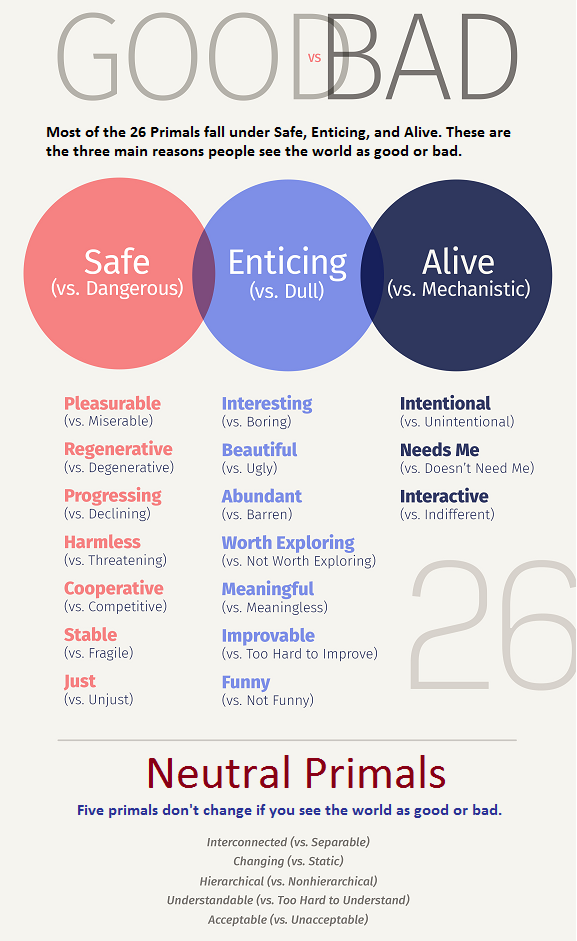
What sort of world is this?
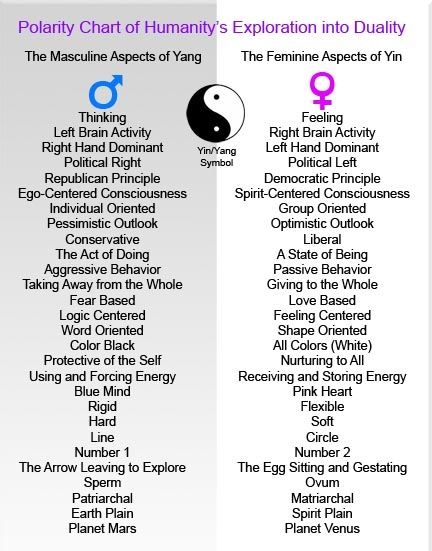
|
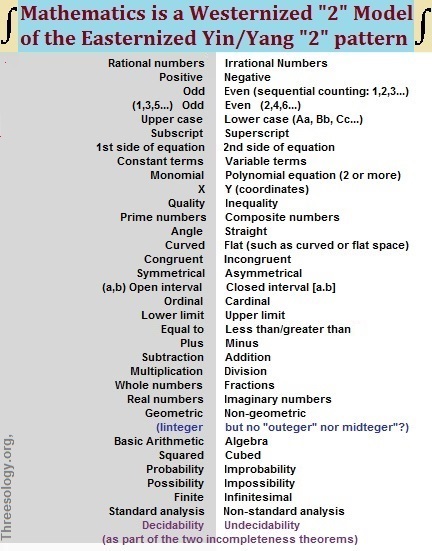
|
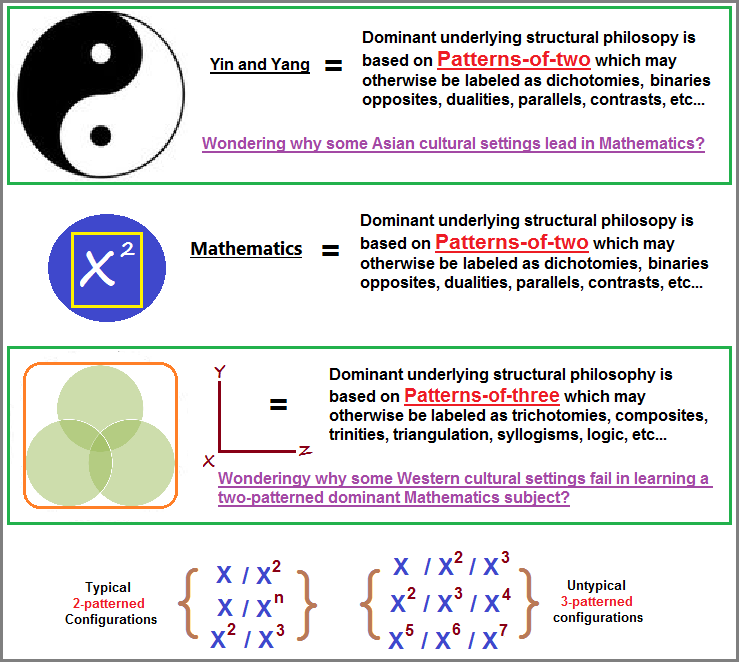 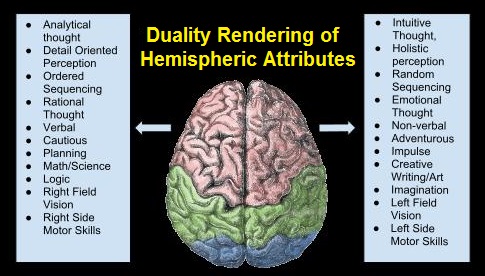 |
|
Source: Mesologue
See also: Persistent Dichotomies I
I sometimes come across a person asking Psychologists (of all people to query) why they persistently see the number three in multiple observations. And of course the typical response is that the person is experiencing some measure of OCD (Obsessive Compulsive Disorder). While this may be true in some cases, one needs to put the situation into a larger context. Such as that if the recurrent usage of a given number pattern is indicative of an OCD situation, then one must surely say that this is what Nature is expression. But more to the point is that the field of Psychology necessarily disparages any pattern that is not conducive to its own OCD situation in using patterns-of-two. It is clearly suffering from an OCD situation:
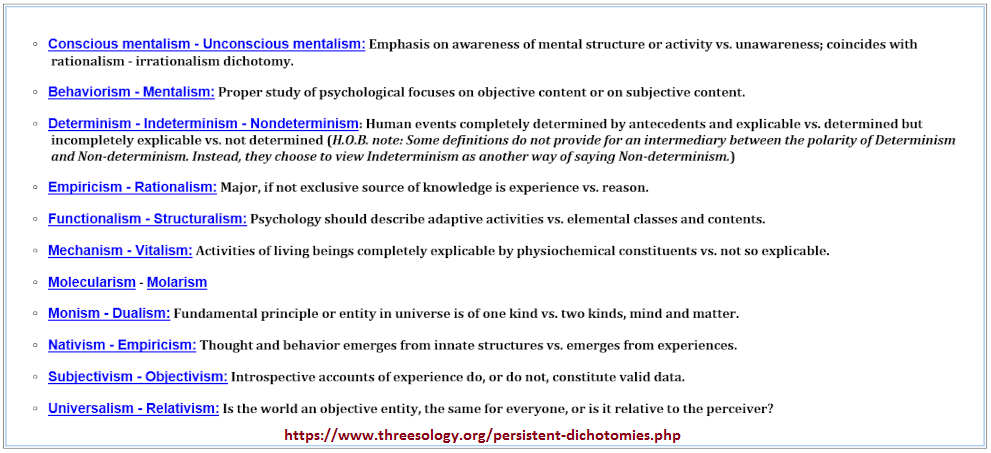
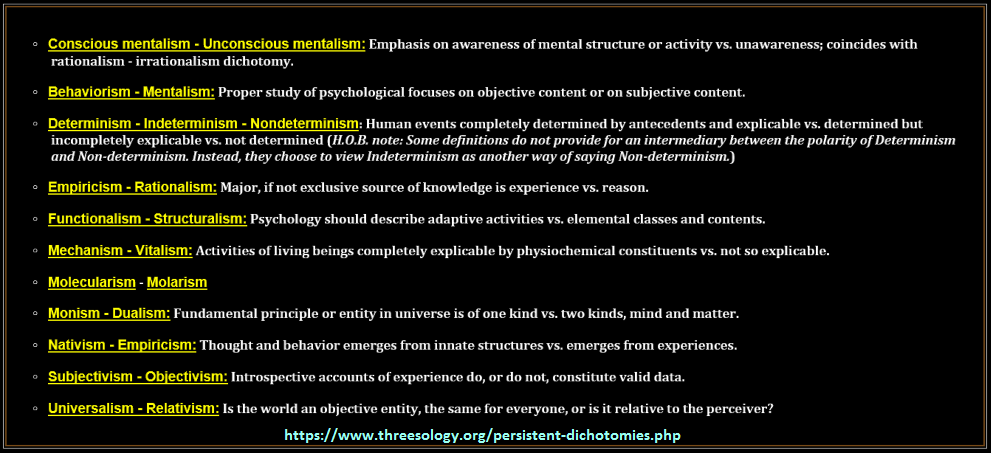
Date of Origination: Wednesday, 4th January 2023... 4:36 AM
Date of Initial posting: Wednesday, 4th January 2023... 4:41 PM
Updated posting: Thursday, 12th Sept. 2024... 8:25 AM
